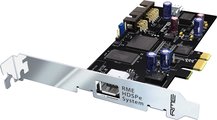In the year 2001 RME started a revolution in mobile audio recording: the HDSP System, consisting of a PCI or CardBus card plus an external I/O-box has been the world's first audio system, operating at both desktop and laptop. And the world's first professional multitrack system for notebooks at all.
Today we are proud to look back and conclude: the HDSP system has become a true 'industry standard'. Thanks to continuing firmware and driver updates it stayed a cutting-edge product, still offers un-beaten performance, and still enjoys great popularity among the users.
The PCI Express card uses RME's own audio bus, already known from the PCI version, operating in combination with Multiface II, Multiface, Digiface and the RPM DJ interface. RME is especially proud on the fact that all users of RME interfaces can easily expand their system so that it operates with the latest and fastest PCI Express computers and Windows Vista, not loosing all the money formerly invested in audio hardware. As additional option the HDSPe PCI card can be used directly with RME's Time Code Option Module, offering an SMPTE controlled operation.
RME's HDSPe PCI Card is not based on a PCI to PCI Express bridge, which would simply add PCIe to existing PCI technology. It is a newly developed genuine PCI Express solution, which consequently takes full advantage of the new format, achieving significant performance gains in multitrack audio. RME's flash update technology ensures future firmware improvements, adjustments, and bugfixes to be installed easily at any time.
The PCI Express interface of the HDSPe system is based on the PCI Express Base Specification v 1.1. It represents a 1-Lane PCI Express Endpoint Device and supports 2.5 Gbps line speed. Thanks to the packet-based full duplex communication, the card provides a transfer rate of up to 500 MB/s - 250 MB/s in each direction.
The connection between PCI Express card and I/O box is established using ordinary FireWire cable (IEEE 1394, 6-pin). The data transfer does not use FireWire protocol, but RME's own proprietary bus protocol. The supplied cable is 4 m (12 ft.) long. The PCIe card operates as power supply for the attached I/O-box (Digiface, Multiface, Multiface II, RPM) over the FireWire cable.
Short PCI Express card
1-Lane PCI Express Endpoint Device (no PCI Express to PCI Bridge), revision 1.1
250 MB/s transfer rate per direction
Secure BIOS Technology: card stays fully functional even when the flash process fails
Output: IEEE 1394 connector, RME bus protocol
Package contents: PCIe card, cable 4 meter (12 ft) IEEE 1394a




